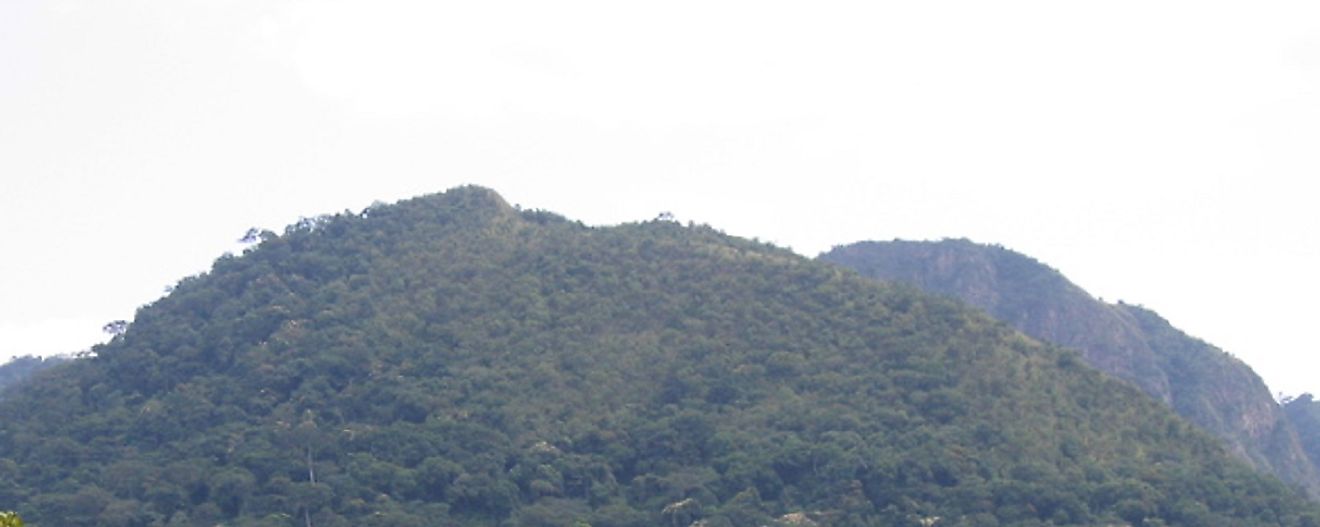Tallest Mountains In Ghana

Ghana is a country in West Africa lying between Togo and Ivory Coast. It also borders the country of Burkina Faso, and its total area covers 283,533 square kilometers. The country is slightly smaller than Oregon and the terrain in the country is primarily low plains with some dissected plateaus in south Central area. Ghana has a mean elevation of 623 feet (190 meters) and the lowest point is at the Atlantic Ocean measuring Zero meters above sea level, while the highest point is Mount Afadjato at 2,887 feet (885 meters).
Afadja
Mount Afadja has an elevation of 2,887 feet, making it the highest mountain in Ghana. It sits in the Agumatsa Range, a short distance from the villages of Liati and Gbledi in the Volta region. The mountain derives its name from the Ewe Word “Avadzeto” which means at war with the Bush. There is a plant species on the mountainsides that causes severe irritation. Shielded by the tropical forests of Ghana, the mountain provides a home to many species of flora and fauna. More than 33 species of mammals and about 300 butterfly species live in the ecological region. Also, regularly spotted in the mountains is the Mona and spotted monkeys. The lush green mountains of the ridge mark the country’s border with Togo. Gorges intersect the mountain, and the whole region is well conserved to protect the mountain's natural beauty and splendor from human interference. Rainforests surround the Tagbo Falls located in these mountains and the waterfalls in several stages with a sixty meters fall of the last stage.
Edouka
Standing at an elevation of 2,542 feet, Mount Edouka is the second highest mountain in Ghana. Its location extends into Badou in Togo. The tropical climate of the mountain region facilitates the growth and a development of a wide range of flora and fauna. Mount Edouka locality, in the jungles that separate Ghana and Togo makes it difficult to record its biodiversity. The wild animals are few in these tropical forests, but monkeys, lizards, snakes, birds, and insects are numerous.
Atiwiredu
Mount Atiwiredu is part of the Atewa Range and is found in the Akyem-Abuakwa region of southeastern Ghana. The mountain rises to 2,539 feet above sea level. The mountain range stretches north-south with steep-sided hills and fairly flat summits. The Atewa Range is the only remaining evidence of the Cenozoic Peneplain that covered southern Ghana. The mountain has bauxite-containing soils. The reserves are maintained by the Forestry Commission of Ghana and key stakeholders like the Okyeman Environmental Foundation. The management restricts any form of farming in the area and encourages eco-tourism. So far critical threats facing the mountain ranges are logging and over hunting for bush meat. The gold deposits and low-grade bauxite usually attract miners and may pose a threat in the nearby future. The range provides habitats for bird species like afep pigeon, least honeyguide, common bristlebill, blue-headed crested flycatcher, and the beautiful olive long-tailed-cuckoo. Two rare primate species, Colobus vellerosus (Geoffroy’s pied colobus), and Procolobus verus, (the olive colobus) also live here. Other species inhabiting these regions include 17 rare butterfly species like the Papilio antimachus (has the widest wingspan in the world), and the critically endangered Mylothris atewa. The rivers of Ayensu, Densu, and Birim source from these ranges and the later provides a diamond mining area.
Kwamisa
Kwamisa Mountain in Ghana peaks at an elevation of 2,479 feet. It lies near the Kwamisa Forest Reserve, with Subranum and Ahiruam lying around six and eight kilometers away, respectively. The Opro River Forests Reserve lies 11 kilometers northeast of Kwamisa, Asufu Shelterbelt Forest Reserve West is about 11 kilometers southeast, and Beremi and Domiabra are 11 kilometers southwest of the mountain. Around 21.2% of Ghana's area is forested. However, recurrent droughts brought about the harmattan winds that blow from January to March threaten these forests. Like other mountainous regions around the world human encroachment is the most significant environmental threat facing these ecosystems. Poaching and habitat destruction continue to threaten the wild animals.
Characteristics of Ghanian Mountains
Afadja and most of Ghana's other high peaks are to be found in the Volta Region near the border with Togo. This region provides Ghana’s best sites with many natural parks and mountains. Mount Afadja which rises above 2,000 feet and it is the highest mountain in Ghana. Mount Atiwiredu has a diversified mountain ecosystem and also has gold mines that threaten the integrity of the region. The mountains in Ghana are engulfed by tropical rainforests thanks to the country’s location that lies within the tropics. The mountains provide hiking and mountain climbing areas for visitors and locals. They are also sources of many rivers in Ghana.
Tallest Mountains In Ghana
| Rank | Tallest Mountains in Ghana | Elevation |
|---|---|---|
| 1 | Afadja | 2,887 feet |
| 2 | Edouka | 2,542 feet |
| 3 | Atiwiredu | 2,539 feet |
| 4 | Kwamisa | 2,479 feet |
| 5 | Pakesie Bepo | 2,388 feet |
| 6 | Etebelea | 2,335 feet |
| 7 | Foto | 2,252 feet |
| 8 | Atiwiredu | 2,214 feet |
| 9 | Sassaboula | 2,185 feet |
| 10 | Bepokaw | 2,153 feet |











